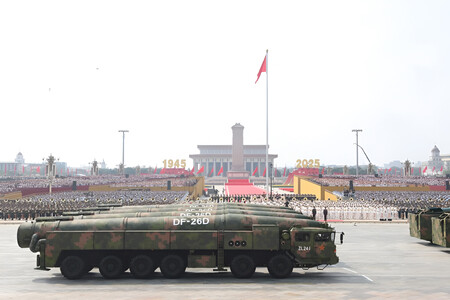At more than 6,000 km/h there is no room to think twice. The new generation of hypersonic missiles operates in that speed range, a terrain in which the global military balance begins to shift. Russia and China They have already shown systems capable of flying above Mach 5. The United States, accustomed to setting the technological pace, moves forward with more doubts than it would like.
The term “hypersonic” is not military marketing, but a clear category: devices that travel faster than five times the speed of sound. The real complexity comes with the trajectory. Unlike ballistic missiles, which ascend and descend in an arc, these systems can stay relatively low and change course in flight. This ability to maneuver, added to the thermal loads and ionization they suffer when passing through the atmosphere at such speed, explains why their development is so challenging.
Hypersonic weapons enter the scene
Russia was the first to proclaim operational capabilities. Its Avangard system, an intercontinental missile-launched glider vehicle, was announced for service in 2019 and Moscow says it can carry a nuclear warhead. Experts in kyiv also claim that Russia used the Zircon against the ukrainian capital in February 2024. China, for its part, demonstrated the DF-17 and tested the DF-27, which reportedly flew about 2,100 kilometers in 2023 in 12 minutes. In addition, it has shown the YJ-21, integrated into destroyers and bombers, consolidating a more visible deployment.
The United States has focused on the Long-Range Hypersonic Weapon. Dark Eagle has a range greater than about 1,725 miles, that is, about 2,780 kilometers, and a first system valued at about $2.7 billion, according to the Government Accountability Office (GAO). The official plan aims to deploy it at the end of 2025, after a sequence of tests with failures in 2023 and 2024 that the GAO collected in June 2025. In August 2024, the CRS reported the first successful “end-to-end” flight. In parallel, the Navy is leading a common glider vehicle and the Air Force is working on an air-launched glider and a cruise ship with DARPA.
The hypersonic threat tests the most fragile link in modern defense: time. The radar has less useful horizon at low altitude and changes in trajectory break prediction patterns. Furthermore, the dynamics of flight itself generate phenomena that can complicate detection. The forces trying to stop these systems are working on layers of sensors, more advanced tracking algorithms and more agile data links, but it is a challenge that is not yet solved.
What sets hypersonic weapons apart is not just their performance, but the effect they have on the logic of deterrence. The inability to know what type of cargo they are carrying until impact creates fertile ground for misunderstandings. The United States assures that its development focuses on conventional ammunition, but rivals such as Russia and China have shown systems directly linked to their nuclear arsenal, which fuels distrust.

Faced with this scenario, the allies are rearming their surveillance and defense architecture. In 2022, the United States, United Kingdom and Australia expanded their cooperation under AUKUS to include “hypersonics and counter-hypersonics“, with emphasis on distributed sensors, shared intelligence and new interceptors. The objective is not only to have equivalent missiles, but to build a system capable of detecting threats in early phases and coordinating the response between different military nodes. The focus is on the next deployment milestones and on validating that this cooperation translates into real capabilities.
Today, the initial advantage is not on the American side, and that realization has already had an effect on its military planning. Russia and China have moved first and have forced Washington to accelerate decisions and prioritize resources in the middle of a year of technological validation. It remains to be seen whether the deployment planned for this year consolidates a balance or confirms the gap.
Images | People’s Liberation Army | Russian Aerospace Forces
In WorldOfSoftware | China promised them very happy with the catapult system of its new aircraft carrier. Until the US took a look
